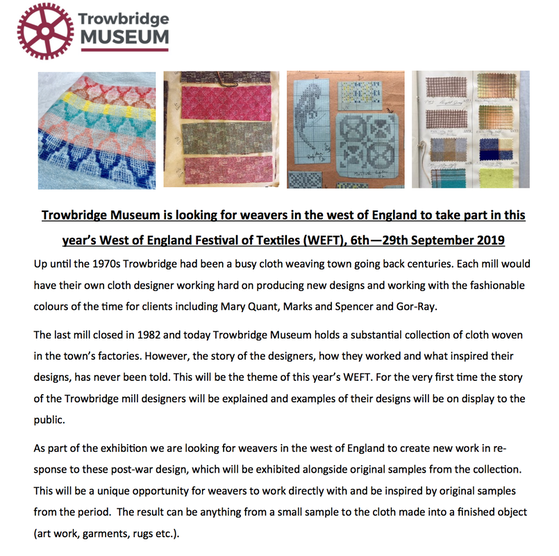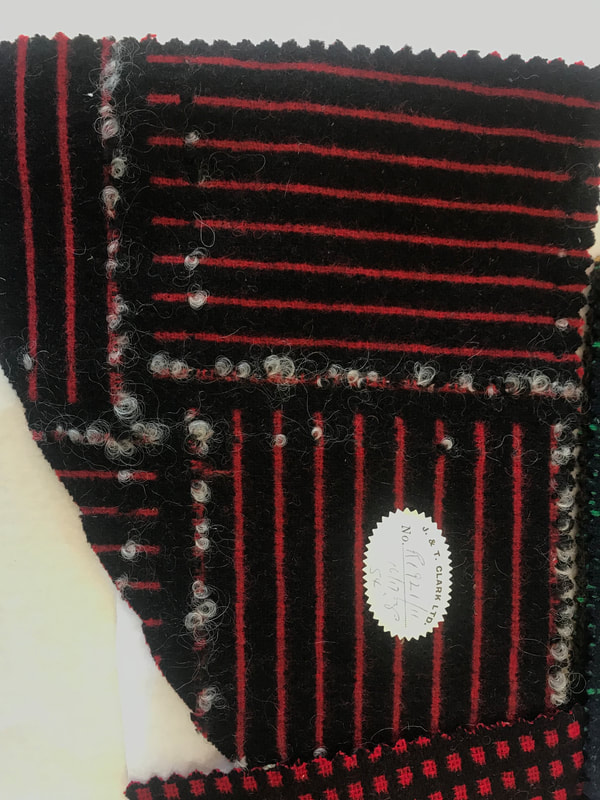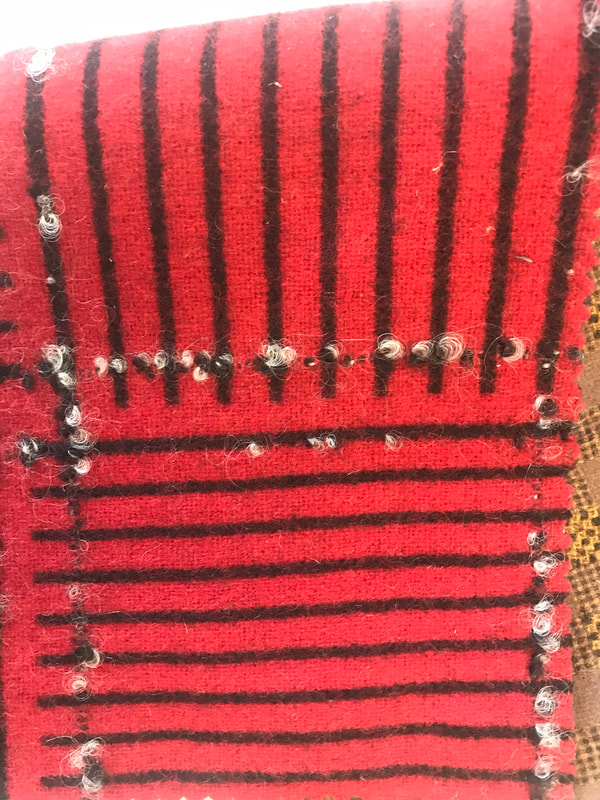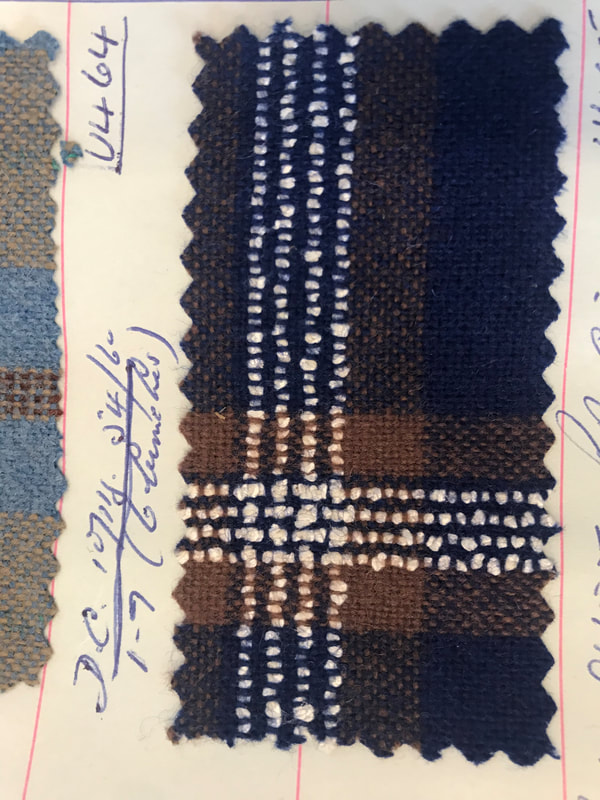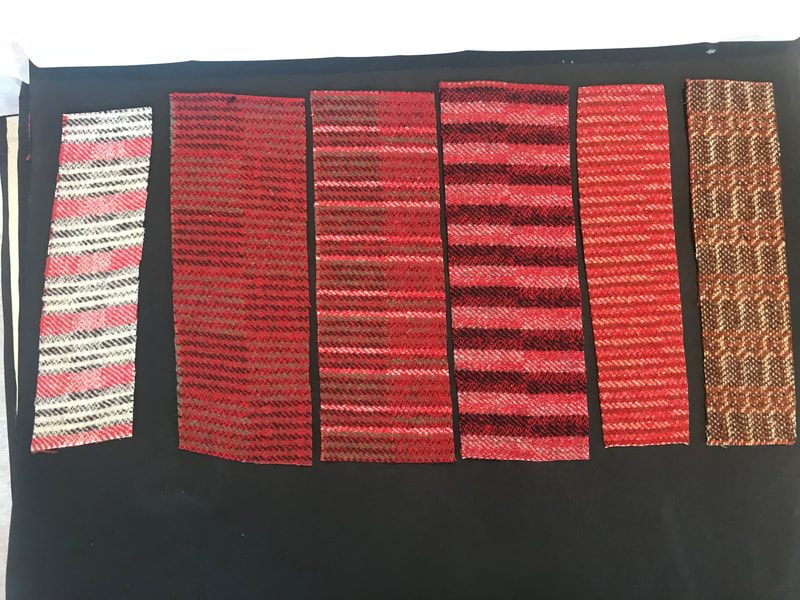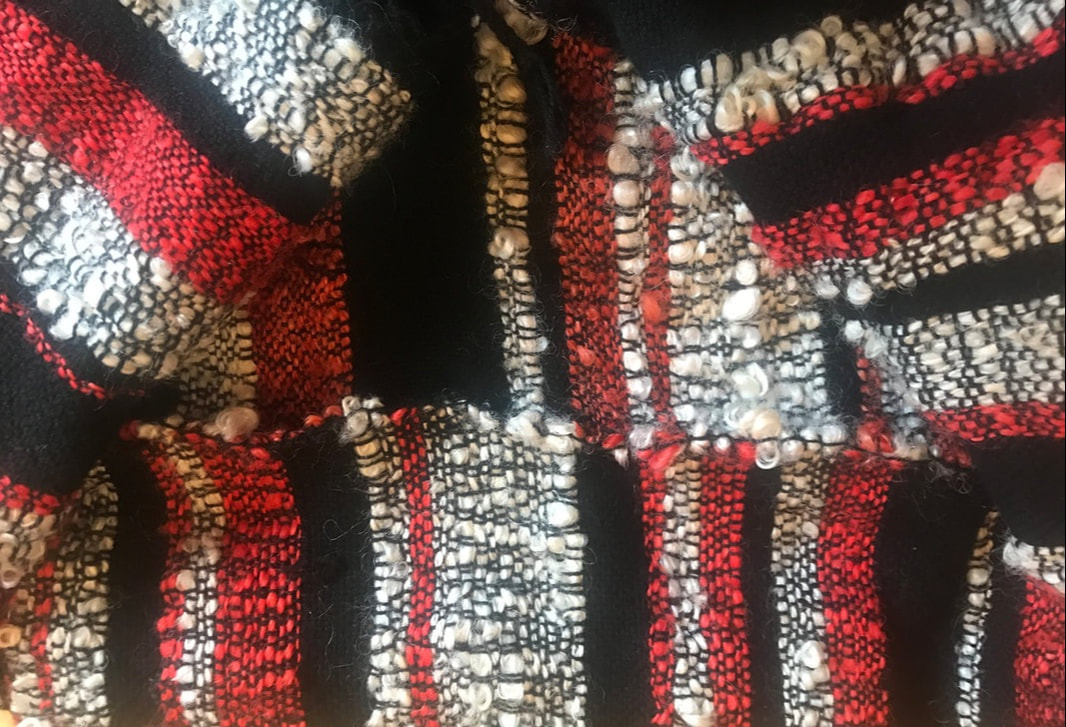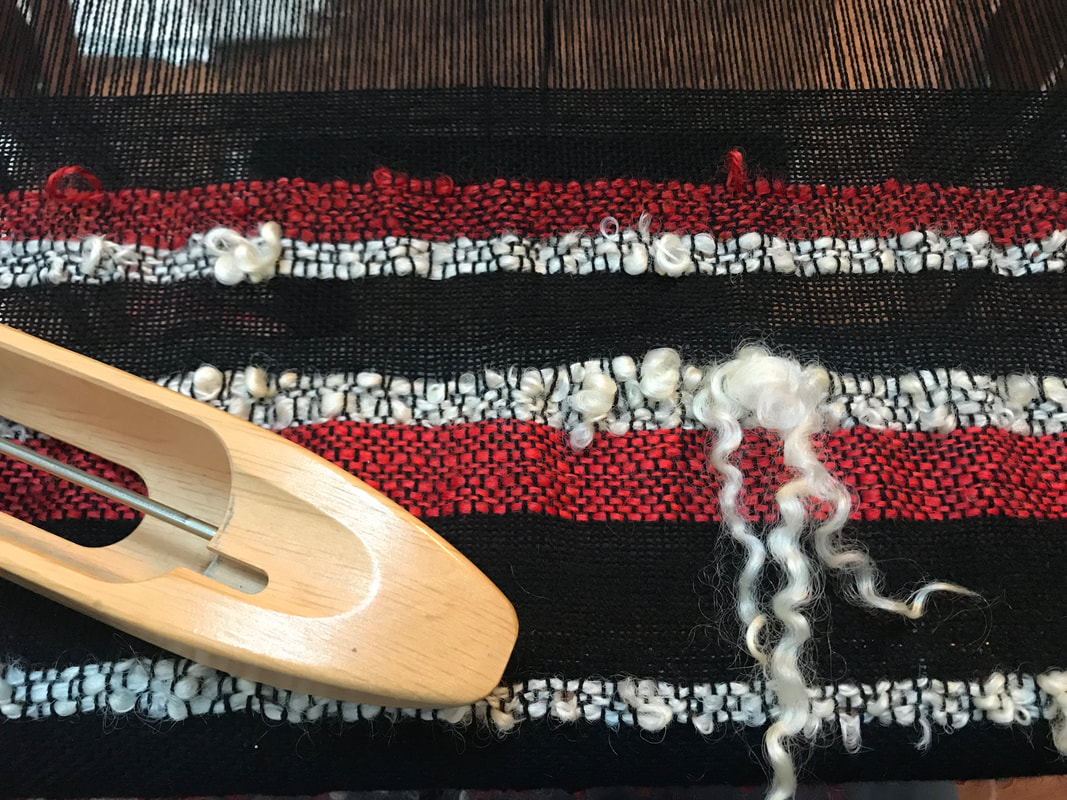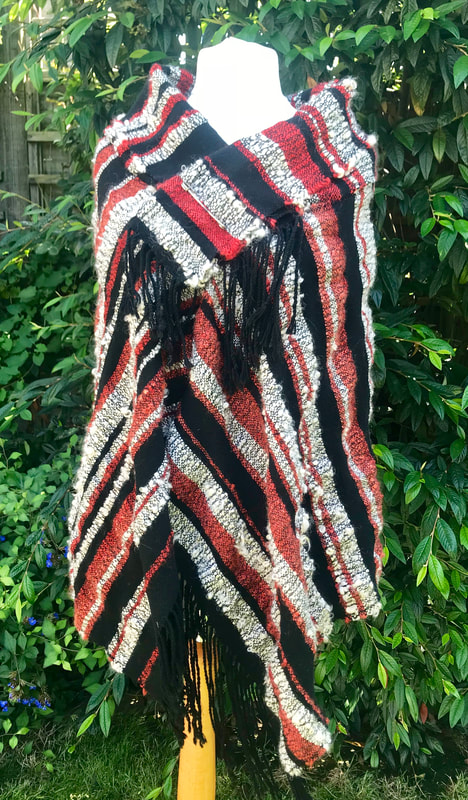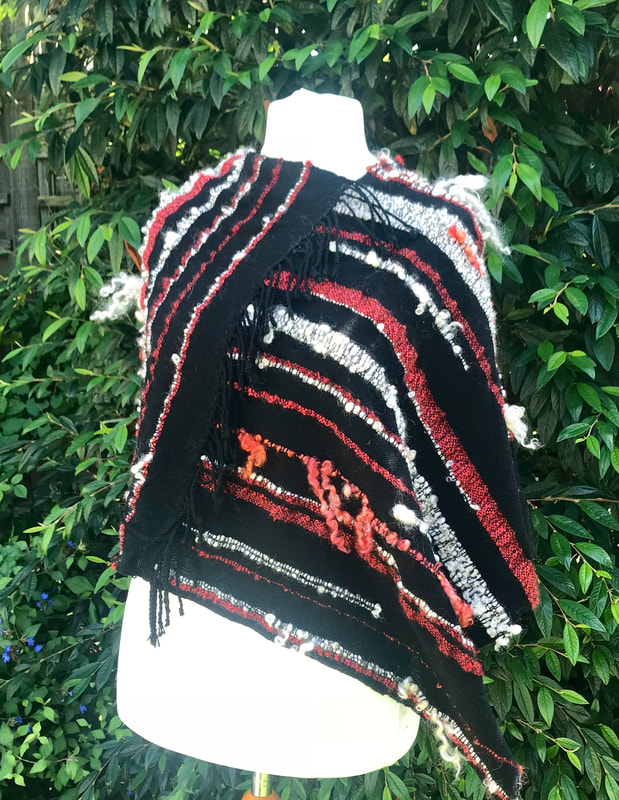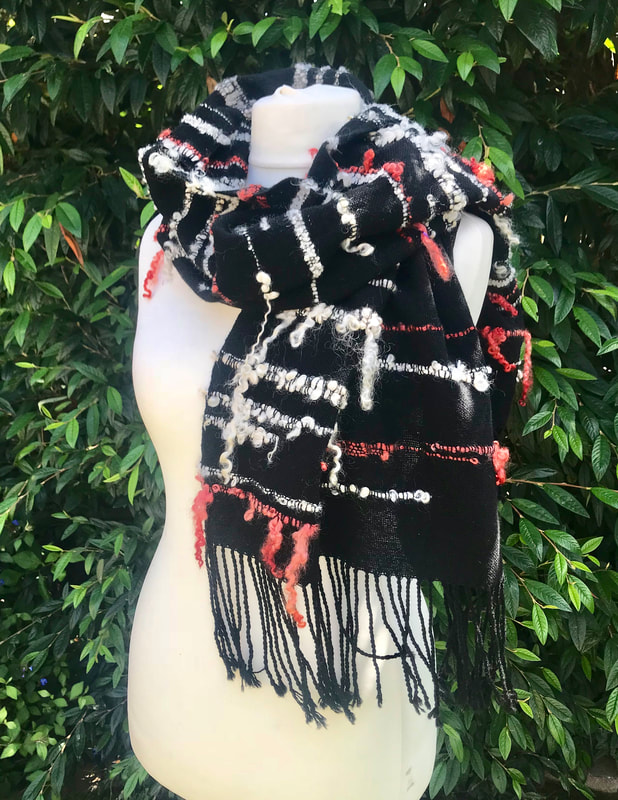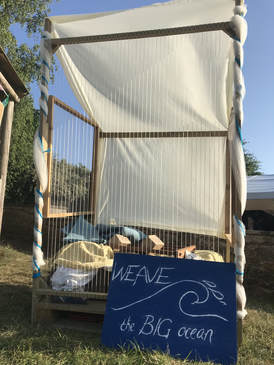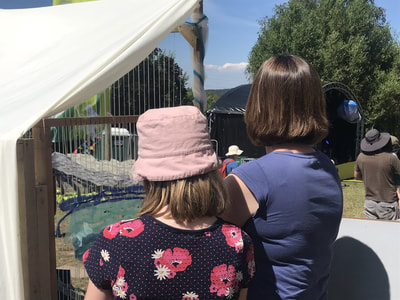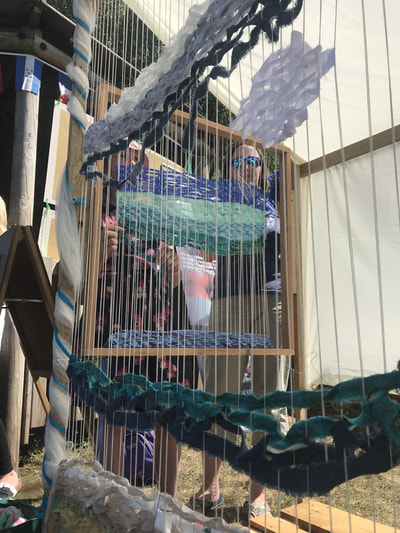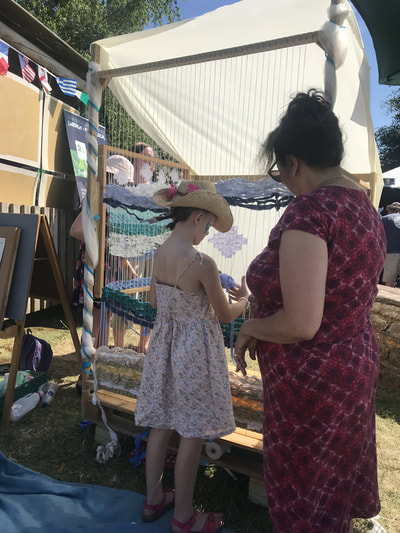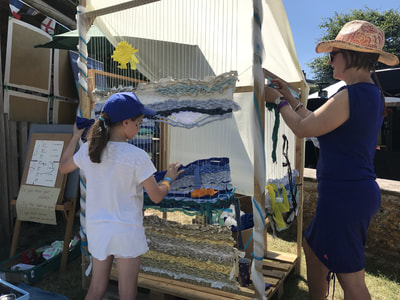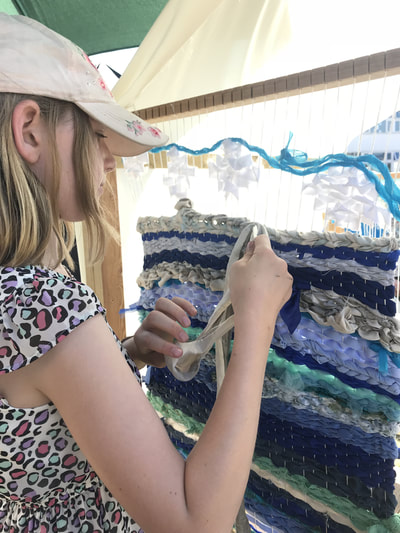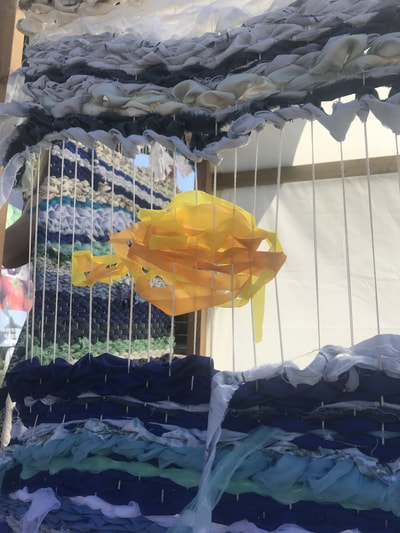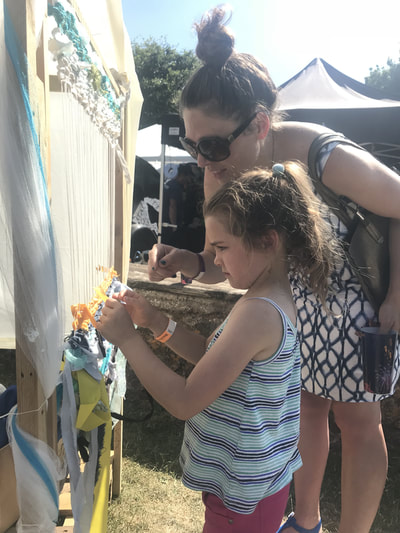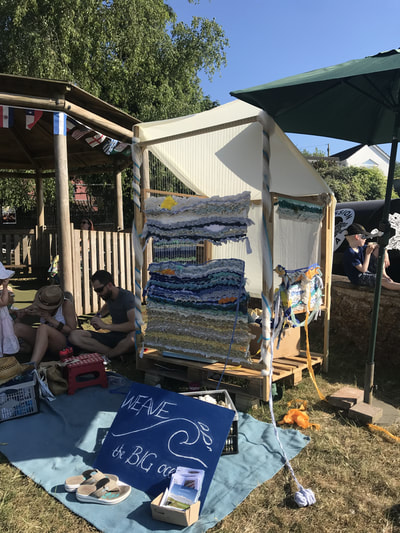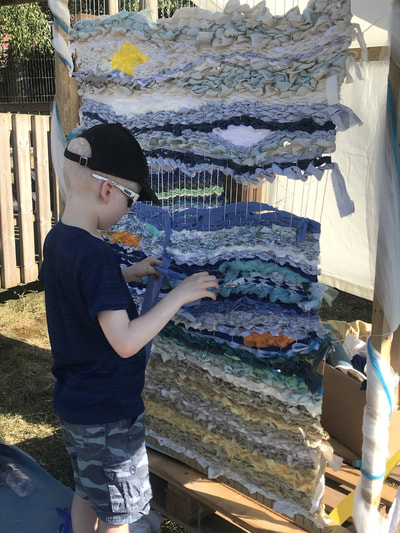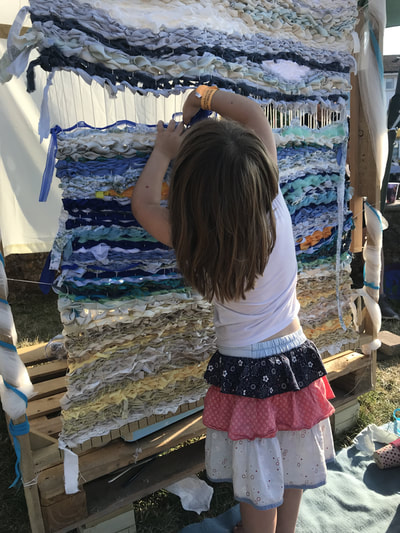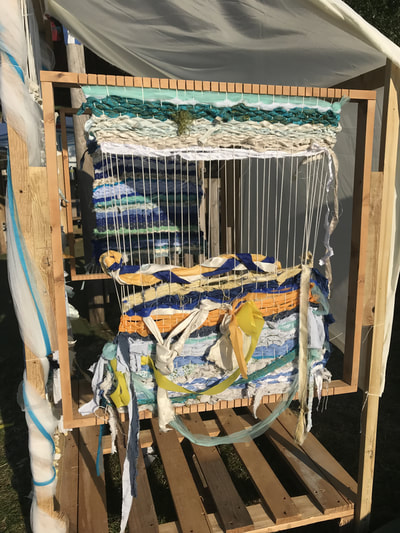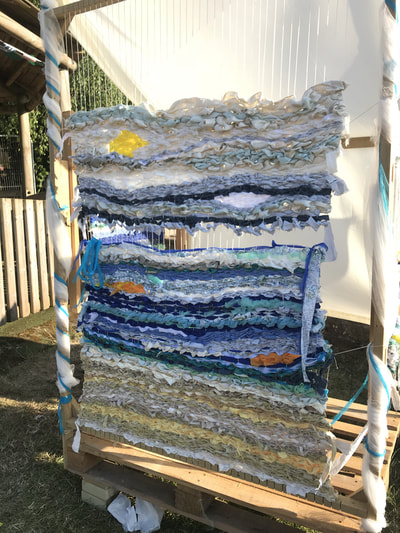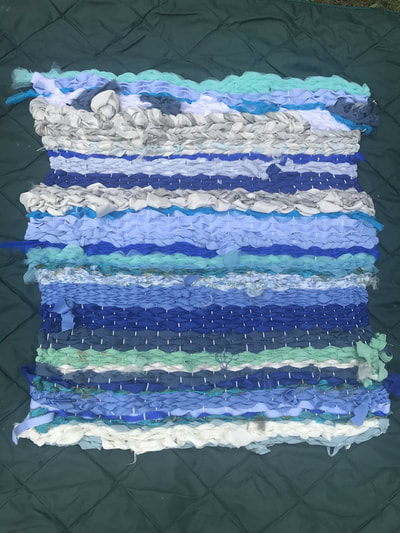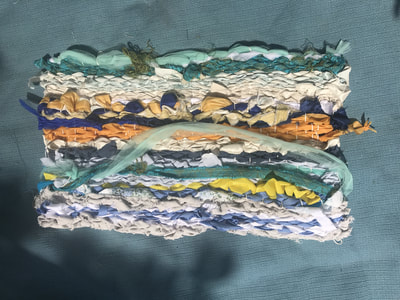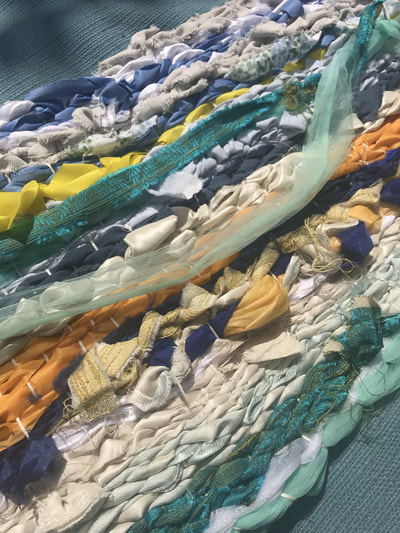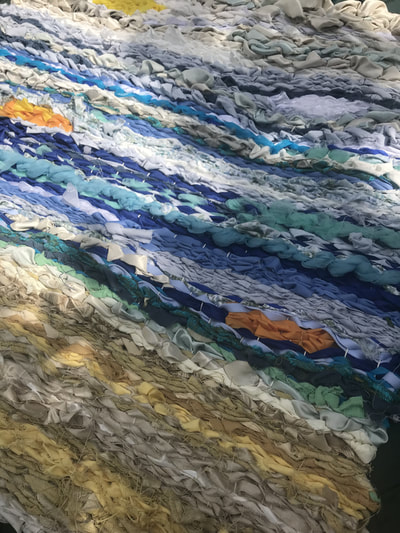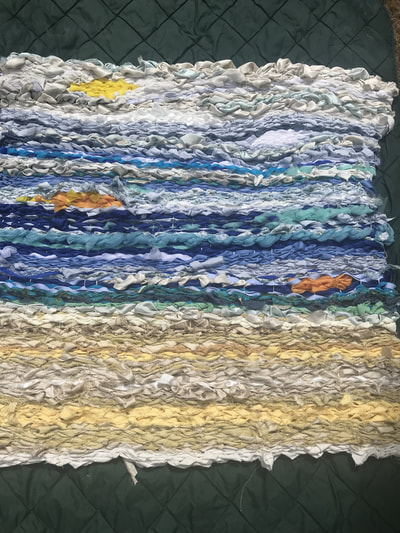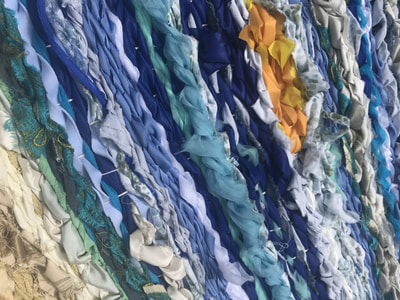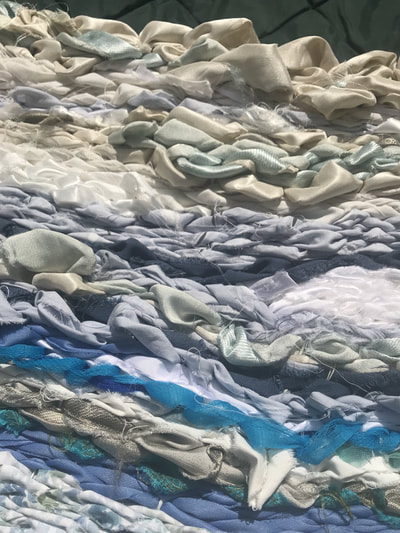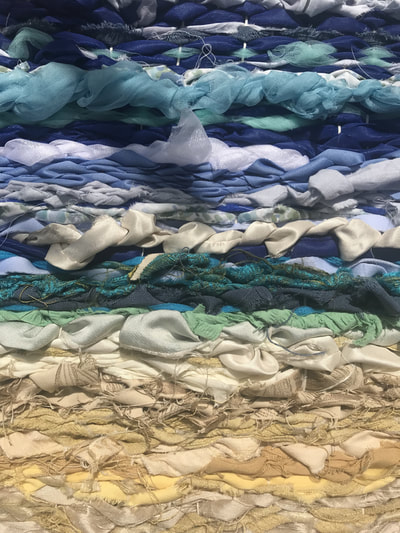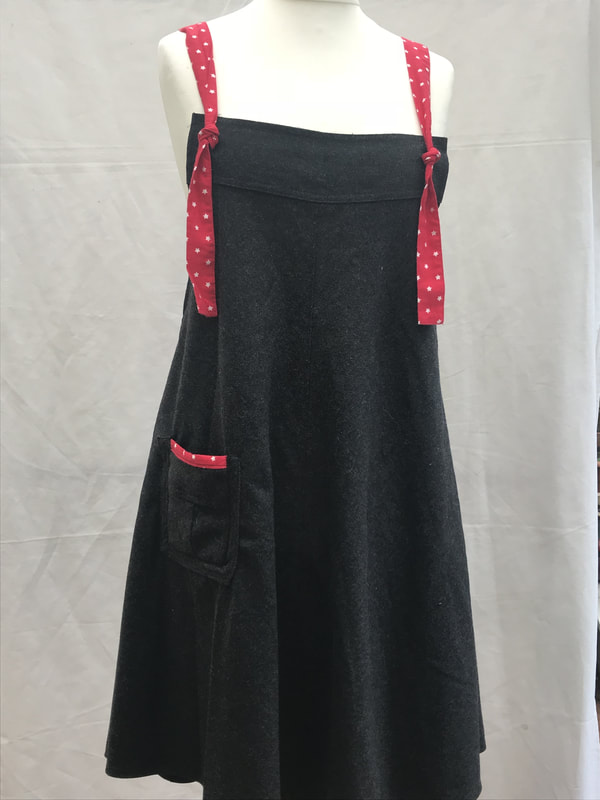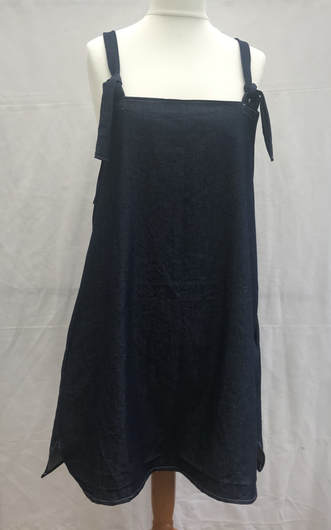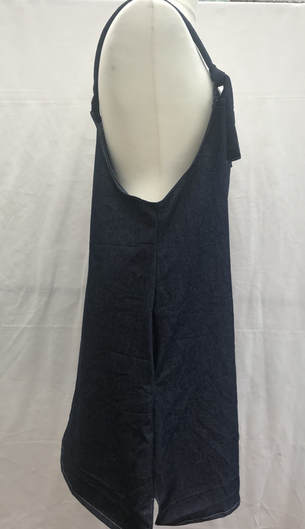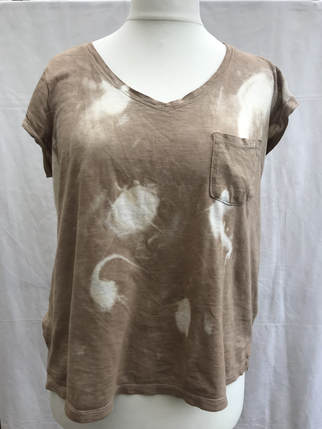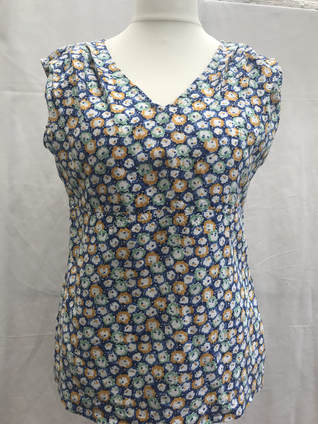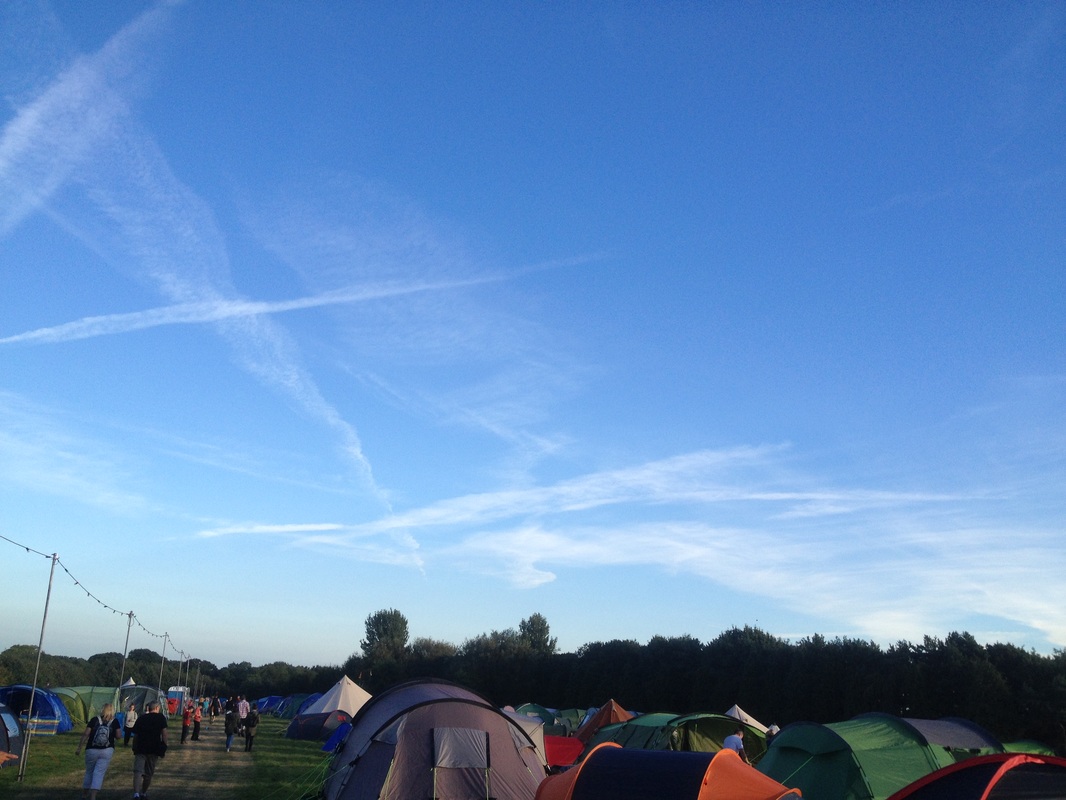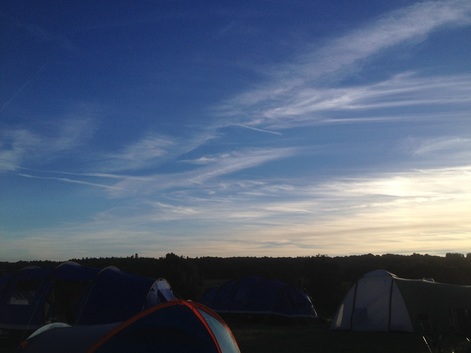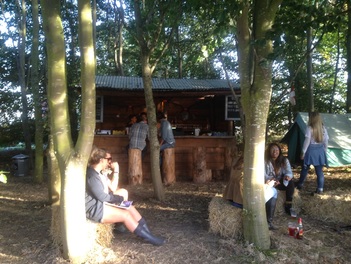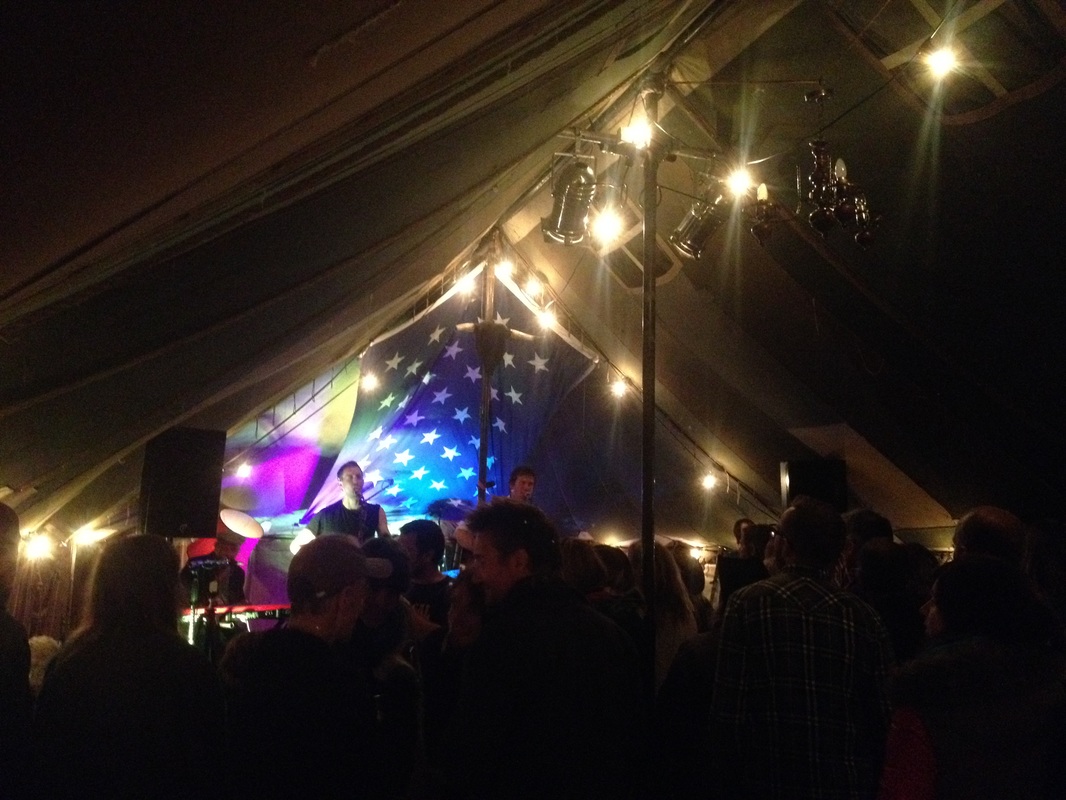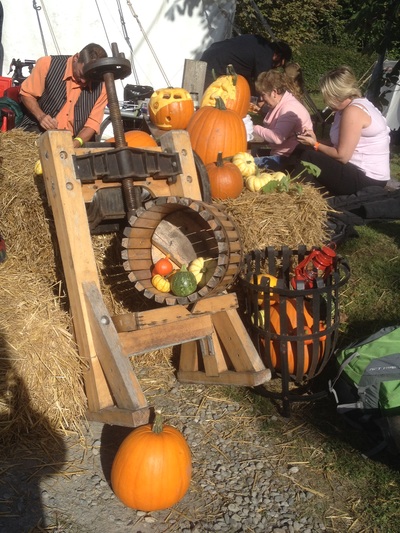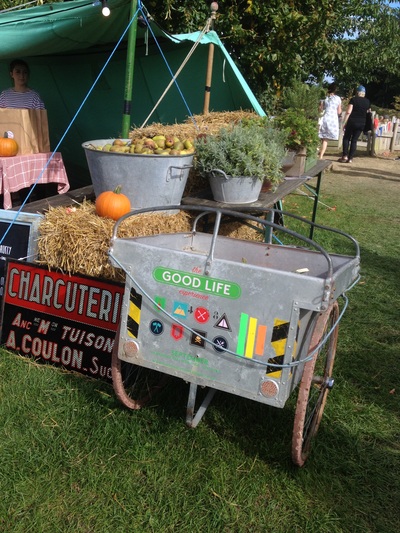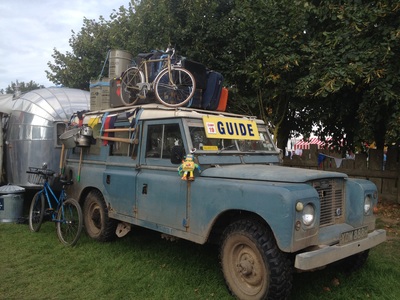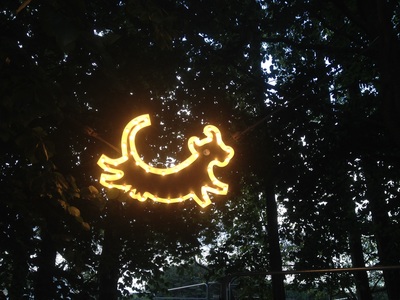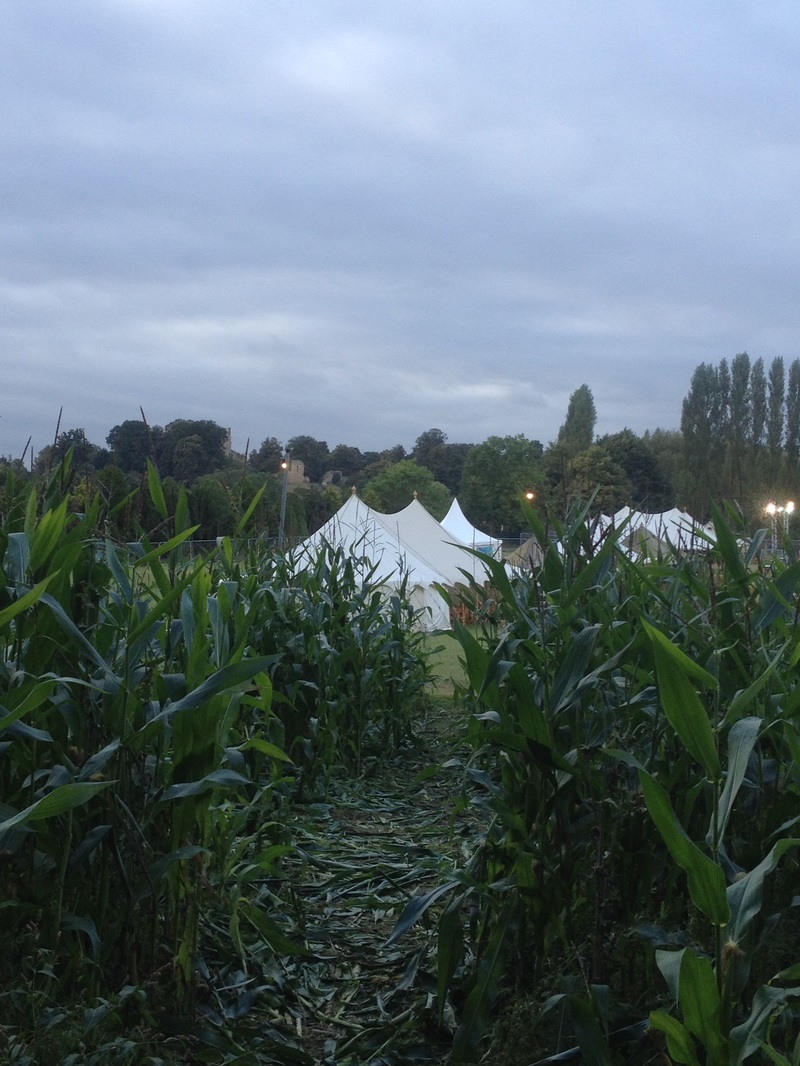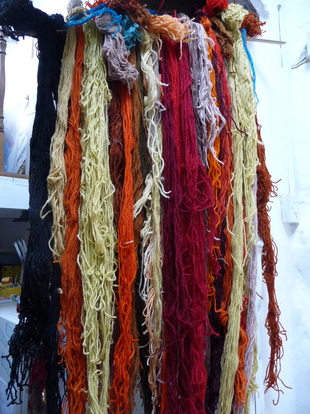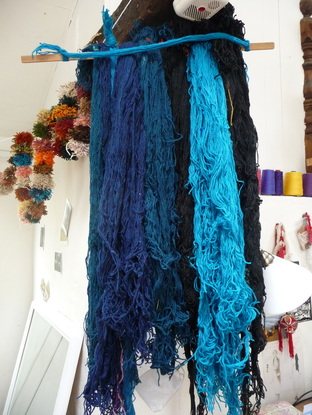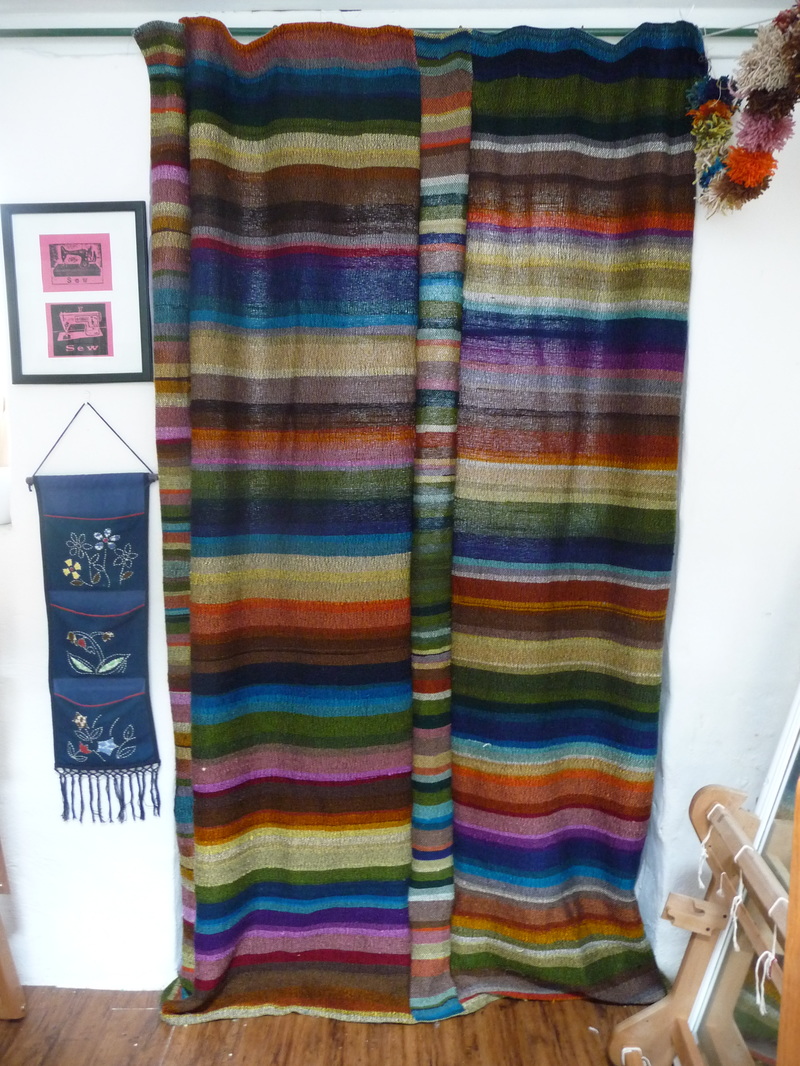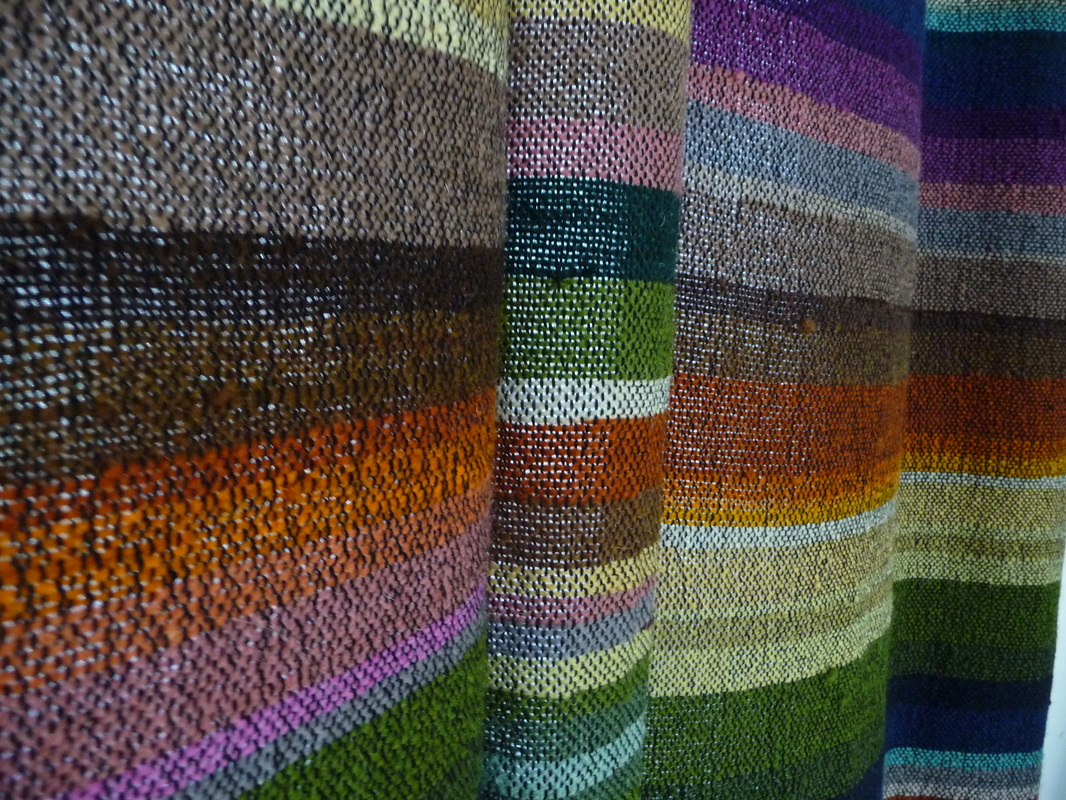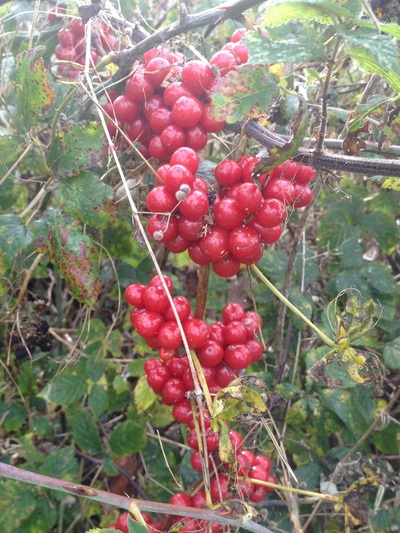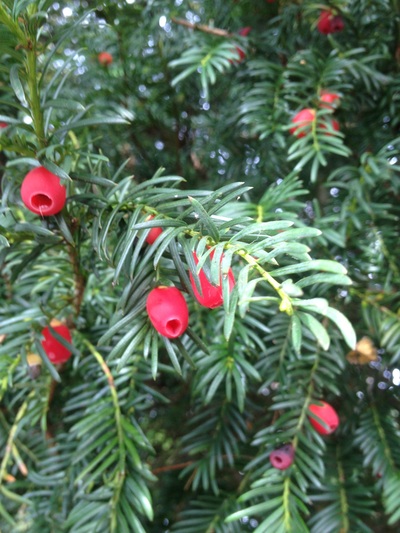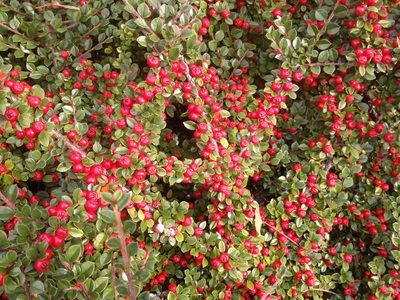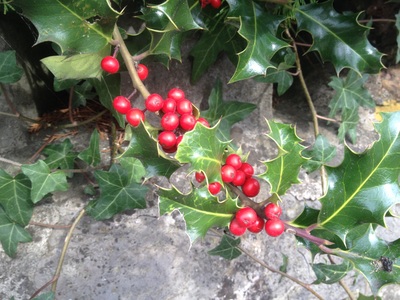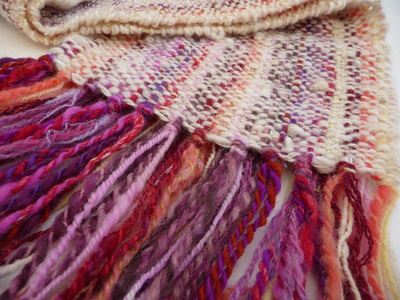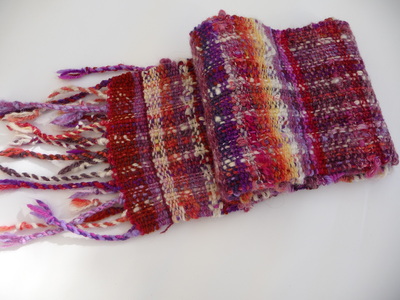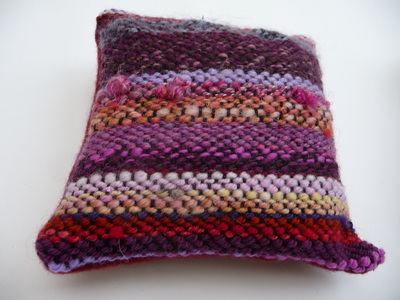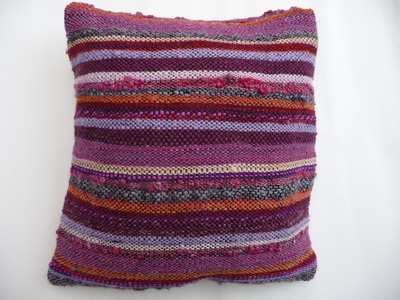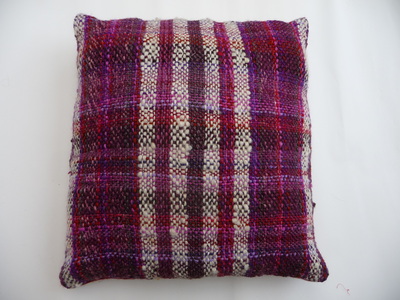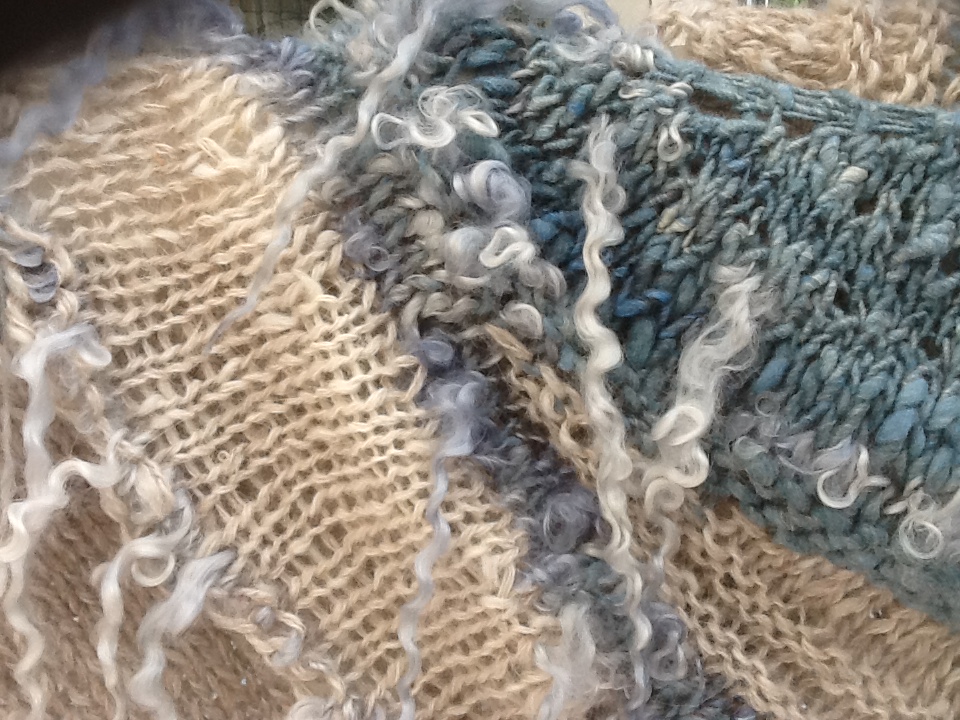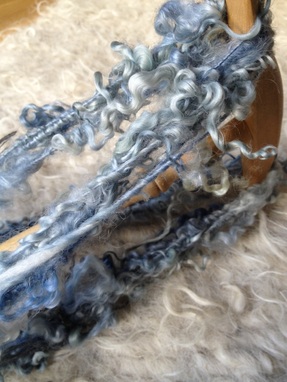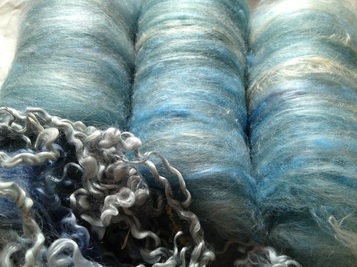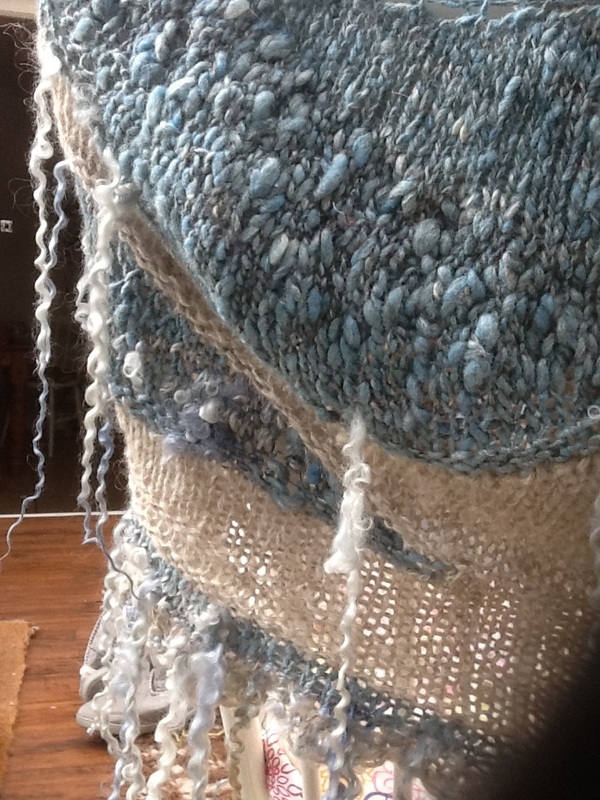|
One of the things that I love about weaving is the feeling of connection is gives me to weavers from long ago. I love knowing that my American 'Macomber' loom has been used by many different weavers over the decades, travelling the world in the process, yet is still being an amazing workhorse for me And I was fascinated to read in a book I borrowed from the British Library that weavers back in Anglo-Saxon times used pretty much the same processes as I do today to hand weave every piece of cloth that they used. So when an email arrived some months ago from Hanne Dahl at Trowbridge Museum asking me if I would be interested to take part in this years WEFT, I didn't hesitate to say 'yes' : I met with Hanne one day back at the beginning of summer and spent a lovely afternoon learning about Trowbridge weavers like George Charmbury and Pat Whitehead, looking at original samples from the museum collection and taking photos of ones that caught my eye: The common theme of the first 3 is the lovely boucle texture while the last photo has less texture but shows a range of samples in the same colours that reminded me of the clasped weft technique that I am very fond of and is often used in modern Saori weaving... In case you don't already know, Saori weaving is a relatively new style/philosophy of weaving, originated in Japan by a weaver called Misao Jo (read more about her here) and apparently her favourite colour was red. Even though I am completely out of my comfort zone with red, an idea was coming together for my weave, a way to weave together the history of cloth production with some modern innovations and inspirations. To test my idea, I used my little Louet Erica loom to weave a sample for the project using some red, black and white yarns on a back warp. The black yarn was a Scottish lambswool that I had bought a while ago and the red and whites were my own handspun and handdyed Cotswold and Teeswater yarns. I wasn't sure about the sample as it felt quite heavy and a little stiff but, to my delight, once washed, it bloomed into the most gorgeously soft, warm and comforting length of fabric :) Now that I knew (roughly) what I wanted to weave, I moved over onto my Japanese Saori loom to start on the main piece. One of the useful benefits of a Saori loom is the pre-wound warps that are available so I bought a 30m black wool warp and set it onto the loom. I gathered my weft yarns, some used in the sample and some additional ones from my collection, that spoke to my mood and, in true Saori style, started to weave, letting the cloth take me where it would... Thinking about Pat Whitehead and the cloth that she had designed and woven for Mary Quant many decades ago, my intention had been to simply weave a length (maybe lengths of) cloth that could be used to make clothing in the future. Weaving can be a very meditative process though and, as I worked, I was thinking more and more about ideas around why we weave cloth, about the sorts of clothing that meet our most basic of needs (for protection, warmth and comfort) and how very soft and warm and comforting was that sample piece of fabric I had made... Ponchos! Warm, comforting clothing, I LOVE a good poncho. My cloth would become a simple, enveloping poncho. I settled into my routine and the cloth grew and grew... Weave and meditate, weave and meditate.... We don't just weave textiles for function though - even the Anglo Saxon weavers added decoration to some of their clothing weaves - and nowadays we have access to an ever-increasing range of yarns and techniques for embellishment. In my own weaving and spinning practice, I focus on using recycled and upcycled textiles, and spinning my own yarn using local fleece and other sustainable and ethically-sourced materials. Amongst this, one of my trademark yarns that I love to create is tailspun yarn. These yarns are definitely much more decorative than functional and are another example of how a traditional skill (spinning) has developed with modern innovations and techniques. I went back to my yarn stash and found some of my tailspun Teeswater and Wensleydale yarns, some of which I had already dyed some of it red - it had obviously been waiting for just this project... In the end, I wove 3 lengths of fabric and made 2 into ponchos (the heaviest weight and the medium weight fabrics) and left one (the lightest weight) as a wrap. The original length of cloth was the heaviest, with it's wide block stripes. To this length, I added the original sample length of cloth, sewing it onto the larger piece as a collar, fastened with a vintage kilt pin. In the second length I then started to make the block stripes narrower and less regular, interspersed with more of the black yarn, and I also introduced the clasped weft technique and the tailspun yarns, sometimes laying them into the warp to create more extreme textures, sometimes allowing their tails to hang loose. I cut this fabric into 2 length and handsewed it into shape with blanket stitch, chosen to echo the enveloping nature of the poncho. In the third and final length of fabric, I used the tailspun yarns almost exclusively, with just very small section of the block stripes and a lot of clasped weft, focusing on the white tailspun and one side of the weave and just occasionally shot through with a little red tailspun. I left this length as a soft and light wrap, to be dramatically thrown over the shoulder so that the the tails would be allowed to fly. Unlike George Chambury, Pat Whitehead and the other weavers of Trowbridge, I don't need to keep detailed records of my weaves as I am not intending for them to be replicated on an industrial scale, indeed that would be the very antithesis of the Saori weaving philosophy. So instead, the only record I have of my process is here, in this blog post that lives only on the modern Internet. I wonder how the museums of the future will store all this digital information and how they will choose what to keep from all this the modern mass media?
These clothes will be available to see at WEFT in September 2019. I will also be teaching a workshop during WEFT - details of that are here. With thanks and respect to George Chambury, Pat Whitehead, Misao Jo and all the other giants, who continue to inform and inspire innovation. I think it's pretty cool that the village I live in has a train station but then, every summer, it goes super-chilled with it's own music and arts festival... This year I realised a long-held idea for a community art project at the festival that, tying in with the theme of the Festival this year, I called "The Big Ocean Weave", The concept was simple - build a really big loom and invite festival-goers to weave a line or 2 with me so that, together, we would create an artwork that would be a lasting representation of the event and a positive statement about community, sustainability and resource-sharing. 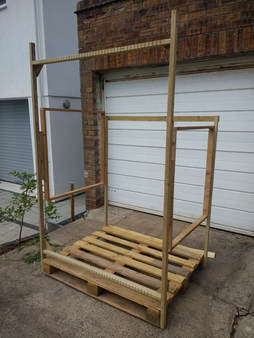 My woodworking skills being minimal, I appealed for anyone in the village who could build me a loom and I'm so grateful that Ian volunteered despite not really understanding what he was volunteering to build! I showed him a home-made recycled picture frame loom of the type I use in workshops and a smaller commercial tapestry loom and asked him to make "something really big like this". He didn't disappoint - it was a great big loom! It was built using recycled wood, some from my garage, some from Ian's and a wooden pallet from a mate. And it was in 3 parts, set at different heights to be accessible to all. Next job was to think about warp and weft. I had linen in my stash that would be suitable for warp but for weft I was going to need a LOT of fabric. I had some but again I appealed to the local community - did anyone have any large pieces of fabric, old curtains, bedding or similar fabrics that they would be willing to donate, preferably in ocean colours but I could dye fabrics so I was open to all offers? In just a week, my living room looked like a fabric shop and I had to prep it all for weaving! And so, every evening, whilst watching tv, I cut fabric, cutting it into strips, joining them together.... I watched a lot of Newsnight..... The following is a gallery of photos from the weekend weaving. It really was a joy to see so many people involved with the weave: At the end of the festival, I took each of the 3 weavings off their loom panels and finished them very simply, squaring them off and tidying up any loose ends but deliberately not adding or taking away from any them. And so the finished pieces looked like as follows. I don't yet know where they will hang but I hope they will find a space in the village soon where they stay as a celebration of community and a memory of one beautiful weekend in our long hot summer of 2018.
It's June 1st already - where is 2018 going? I have spent a happy month quietly taking part in Me Made May, the annual love fest for handmade clothes. The idea is simply that participants around the world just declare that they want to take part and set themselves a challenge for the month. It's often a challenge to wear a me-made item every day and many people post their wears on Instagram every day under the hashtag mmmay18 or memademay18 so there's some fabulous inspiration there if you fancy a browse My personal challenge for the month was about really taking some time out to work on my technical dressmaking skills and to create clothes that fit and/or flatter my new body shape (anti-cancer hormone therapy meds are not kind to the figure...). Some of my new makes were favourites right off the sewing machine, some were maybes/good learning experiences and some went straight to the rag weight bag for the charity shop! Here are some of the makes that survived the cutting room floor: First up are the dungaree dresses - my absolute fave makes! Regardless of how flattering this shape is or not, these are so comfy and versatile that I can see them being wardrobe favourites for ages. The first one is an upcycled make - I had a wool-mix maxi skirt that I'd bought from the local charity shop and cut it slightly to make this dungaree dress. I used a red ribbon that had come wrapped around a gift pack of pjs for the shoulder straps, using the belt loops in the original skirt for the loops, and used the small amount of scrap fabric to make a cute pocket. An almost zero-waste make! The second is a cotton dungaree dress for the summer. It uses the same basic pattern but is less flared and has small side seam slits at the hem due to the narrower fabric width. It also has side seam pockets instead of a front pocket and I made loops and shoulder straps from some extra yardage. Next up are a few re-models/recycles. These are experimental - I take a garment that I won't wear anyway for some reason and play with it to see what can be done. The first is a plain white cotton t-shirt that had become grey and tired and had a small but very noticeable stain on the front. I dyed it with tea-bags to start with - nice colour but made the stain even more prominent and showed up a few more! So then I splashed bleach over it to brighten the stained areas, with a few extra splashes for added balance. Love the effect now. It's not a great colour next to my face but definitely worth trying again maybe for a skirt, a mixed fabric dress or even just for bags. Now comes a linen top that came from Kew. Nice linen fabric, very cool in summer and a colour way that goes with lots of things. But the top had gathers on the shoulder fronts and under the bust that made it look really blousy and maternity-like - not a good look... So I took out all the shirring elastic in the gathers, cut a couple of inches off the sides with a bit of extra waist shaping and then added an invisible zip in the side seam. Result is not great (I should have taken more off the front than the back to make the armhole a better shape I think) but definitely more wearable that it was. And finally, the Schoolhouse Tunic that started the whole month off for me? Still a wip for now! I spent ages learning how to do a FBA (full bust adjustment) in different ways for different fit effects and now the top part fits very well but when I sew it to the bottom half of the tunic, it's still really too wide to be flattering... I'm completely dithering over whether to leave it as it or dart and shape it some more, which will mean inserting an invisible side seam zip.... Maybe next month....
I've really enjoyed my playtime this May and more sewing is definitely on the cards. To keep up with my further adventures with a sewing machine, do follow me on Instagram or Facebook. Back from a fabulous visit to Alberta, Canada. I think I'm still a bit too jet-lagged for fine words so this is a simple photo-heavy blog post - I've chosen some photos to try and share the beauty, the peace, the moments that were so awe-inspiring, that lifted and soothed my soul ... Hope this slideshow inspires in you the same peace that it did in me....I've set it on a 9 second timing, so it's enough to give 1.5 minutes of peace. Hit play, sit back, relax and enjoy...... 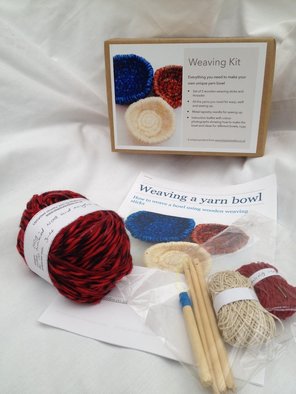 The new year brings a new look to my weaving kits. I launched these kits last year but thought that they needed more sturdy packaging and this month was the perfect time for a revamp. The yarn bowl weaving kits now come in a strong cardboard box ready for wrapping as a present or sending by post and the labelling has also had a smart new look. Inside, the instruction leaflet has also had a rewrite using a publishing software - same content, smarter look. They are for sale from my etsy shop. 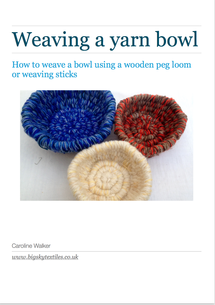 Also this month, I have launched a new e-booklet! This 14 page PDF booklet is a longer version of the instruction leaflet that comes in the kits, with step-by-step instructions and colour photographs for weaving a yarn bowl using both weaving sticks and a peg loom. It's for sale as an instant digital download from my etsy shop. If you have any comments on my kits or would like you know anymore about them, please do get in touch. I don't blog very often (you will have noticed that..) but my recent weekend at The Good Life Experience so resonated with much of my work-life philosophy that I felt drawn to write about it and share some photos. Grab a cuppa, sit back and relax for a few minutes... Spending time outdoors with good friends and good food, dancing and discovering new music, stimulating debate, and finding quality products from British craftspeople that will last for years - these are all important parts of my good life. Here are some of my festival highlights: For a start, the weather was gorgeous all weekend, which meant long days and evenings sitting outdoors enjoying the sunshine, the sunsets and those big blue skies. 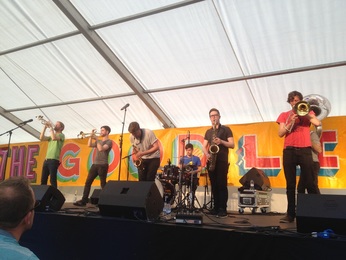 Lovely weather also meant for easy camping. George (the camper van) was parked up next to the festival site in the Scout campsite, which was spacious, peaceful and amazingly well-equipped with toilets and showers. We parked next to a huge tree, and watched dogs and small children play underneath it with leaves and twigs. The weekend was already looking like a winner before the fun had even started. The music was a treat. In best festival fashion, the most exciting and enjoyable groups were the ones we just happened across. Just walking past the main stage for example, we were drawn in to see the Booka Brass Band, who were just terrific. We bought their CD after the set and had a very jolly drive back home with it playing on LOUD. Other musical highlights were Friday night dancing with Geordie MacKeeman and his Rhythm Boys (ditto the CD) and the delicious Sunday lunchtime treat of "Recomposed": by Max Richter, performed by Mari Samuelsen and the 12 ensemble. 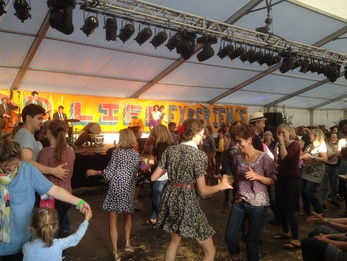 Alongside the very groove-worthy Booka Brass, were plenty of other chances to dance too, including the super-fun Swing Patrol dance class. A good festival always needs good food of course and the Good Life had plenty of that. I loved all the dahls (yes I did try them all), there was the best goats cheese I've ever had, the coffee was awesome, Calon Wen's frozen yogurt was a revelation and their cheese was deliciously tasty. And then there was just a little bit of alcohol... there were cocktails (mine's a Honey Whisky with FeverTree Ginger Ale please), Tincup whisky in the woodland bar, and Black Cow vodka, served up in the wonderful honky-tonk Black Cow Saloon. In between the music and refreshments we also went shopping. This was really unexpected, as I'm not usually interested in shopping at festivals. But the quality and practicality of the products for sale by the small-scale vendors was exceptionally good. I love my new iron wok from Netherton Forge and we bought enough magazines and books to provide several months of quality reading and inspirations for new things to make at home.. I was particularly pleased to see Cambrian Wool there, who are working to help sustain traditional upland farms and rural communities in Wales by making Welsh wool popular and sustainably processed in the UK.
There were interesting talks throughout the weekend too - we particularly liked the very entertaining Mark Shayler on "what is Britain for if we don't make things?" And the whole site was decorated with a beautiful aesthetic - see photos below - making it a feast for all the senses. A good life experience indeed. And dog-friendly - hooray! Big Sky's dog is still struggling with his travel anxiety problem so missed the fun this year but fingers-crossed for next year. In a society that seems to be becoming increasingly dog-unfriendly, this festival was an exemplar of how festivals really can be for a whole family. If you have done a workshop with me, you will know that I'm a big fan of recycling, whether it's using old picture frames as looms or weaving with recycled fabrics. I always suggest using old sheets and clothes to weave bathmats or baskets on a simple wooden peg loom for example and relatives often give me their old fabrics for me to cut up and re-purpose. Some time ago I was also given a huge bundle of rug wool thrums - odds and ends of yarns, the leftovers or offcuts from production weaving looms. They looked like this: I am very pleased that today they look like this: My studio is very cold in winter but now it has a warm and cheery curtain covering the front door so that I can still work in there in the dark and chilly evenings. I wove the thrums in random strips of colour on a black wool warp on my Saori loom, then cut the fabric into lengths and sewed it all together. There is a lining fabric for extra warmth - I cut the lining off some old curtains that my mum had given me and dyed it grey, then cut and sewed it to make it match the size of the curtain. The curtain tape on the back of the curtain and the curtain hooks were taken off the same old curtain. Here's a close-up of the new curtain fabric: My mum will say that they are too long and will get dirty at the bottom. They will keep the draught out though :)
I used 14 different handspun yarns in this collection and handwove the pieces on rigid heddle looms. The yarns include polwarth, teeswater (from Exmoor), mule (that's a blue faced leicester cross) and merino. The cushions are all backed with handdyed pure wool fabric and the fillings are plump feather cushion inners.
Some of these pieces are available from my etsy shop at https://www.etsy.com/uk/shop/bigskytextiles or, if you live in the Bristol area, you can also find some lavender cushions and squishy feather cushions at the very lovely shop Tilly's Vintage Treasures in Backwell. "Knit on with confidence and hope, through all crises" A friend of mine recently told me about this quote from the famous knitter, Elizabeth Zimmerman. Apparantly its a very famous quote but it was new to me and struck home as quite perfect for me at the moment, hence the title of my first blog post for a while. I am currently taking some time away from craft markets and my etsy shop while I am having treatment for breast cancer. Obviously I can't not create though and I have been reaching for knitting a lot in recent months. At the same time, I joined the Tour de Fleece this year for the first time. For those new to the Tour, the basic idea is that yarn spinners spin on every day that the Tour de France cyclists cycle on the Tour and participants set themselves a personal challenge for the duration. And blimey what a duration it was - I had no idea before this year how long the Tour de France was. As afficionados say apparently, "Chapeau!" (hats off!) to the riders for taking part in what is an incredibly difficult challenge. 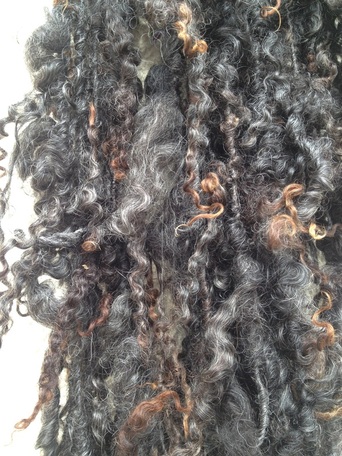 My personal Tour challenge was to learn to spin tailspun yarn. Using a bag of gorgeous dark brown Wensleydale locks, I practised a few different techniques and settled on one that suited these very long locks, ending up with 900g of finished tailspun yarn! Then I tail spun some hand dyed Wensleydale locks: 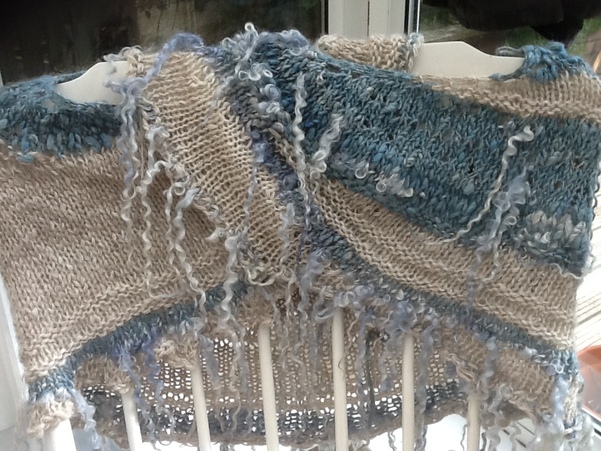 front of finished shawl front of finished shawl So what to do with the tailspun yarn? I met with some Ravelry friends and showed them the yarn, explaining that "its all about waves and the sea and I'm thinking of some sort of shrug..." Immediately, Ann knew the pattern I needed: Thinking of Waves by yellowcosmo I played around for a while with a contrast yarn for the blue and settled on a calming off-white yarn I spun some time ago - I have lost the note of what fibres are in this yarn but I definitely remember cashmere, angora and alpaca amongst the mix - a real luxury yarn. Given that I was working with a much thicker yarn than the one called for in the pattern, I knew I had to adapt the pattern to avoid a shawl that would impossibly big so the shawl that I made was, in the end, more inspired by than faithful to the original pattern. And it has issues as a result - it ended up being 160cm wide when finished which was about right but there are more stitches in a couple of sections than I would like. Overall though, I am very happy with the result - it's light but warm, practical but extravagant. I thoroughly enjoyed the process of spinning the yarn for this shawl and then knitting it and it makes me feel very comforted when I wear it. I think Elizabeth would approve. It's all a bit grey round here at this time of year. The sky is full of grey rain, the garden is resting, and there are no flowers in bloom. So I have been looking at my stash of brightly coloured yarns and thinking about how to put some of that colour outdoors. My initial ideas were around yarn-bombing but I knit too slowly to produce anything very substantial before the Spring, so that really left crochet and weaving. And so the "Four Seasons" garden banner project evolved... 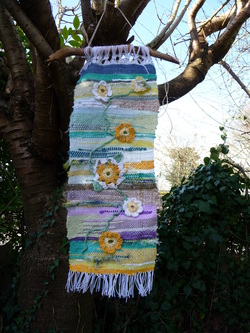 I have been playing a bit with Saori-style weaving recently and like it very much so all the banners are in that style. In each banner I tried to convey the colours and the feelings of that season. Spring, seen here on the left, is full of flowers and cool but sunny skies. It hangs on the cherry tree in the garden, which will soon be a riot of purple blossom. 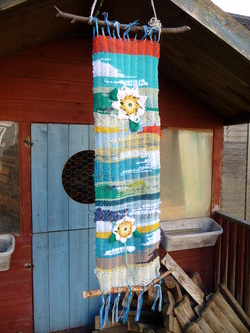 Summer skies are bright blue and warm days are spent by the sea and the beach. There is always lots of ice-cream too - mint choc chip for me and vanila (with a flake) for my son. 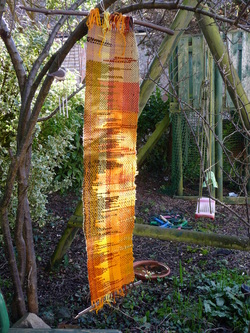 Autumn is a favourite time, the colours are warm and rich and the sun still shines through the abundance of growth in the garden. This banner hangs by the swing seat in the garden, where I love to sit and enjoy the late sun. 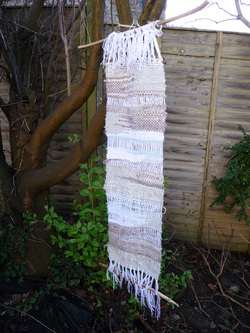 Winter is cold, maybe snowy, always frosty. Mists hang over the fields around our house. Sometimes the muddy puddles in the park ice over. Skies are cold blue. There are some spaces in the weaving to symbolise the bare trees at this time of year. |
AuthorCaroline Walker, blogging as bigskytextiles. This is the space for my big sky ponderings.... Archives
August 2019
|
